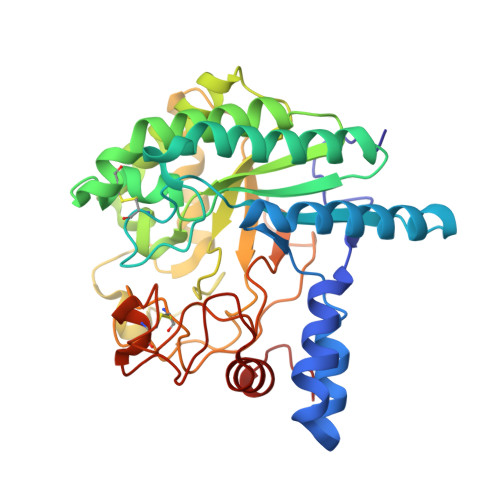Crystallographic Evidence for Substrate Ring Distortion and Protein Conformational Changes During Catalysis in Cellobiohydrolase Cel6A from Trichoderma Reesei
Zou, J.-Y., Kleywegt, G.J., Stahlberg, J., Driguez, H., Nerinckx, W., Claeyssens, M., Koivula, A., Teeri, T.T., Jones, T.A.(1999) Structure 7: 1035
- PubMed: 10508787
- DOI: https://doi.org/10.1016/s0969-2126(99)80171-3
- Primary Citation of Related Structures:
1QJW, 1QK0, 1QK2 - PubMed Abstract:
Cel6A is one of the two cellobiohydrolases produced by Trichoderma reesei. The catalytic core has a structure that is a variation of the classic TIM barrel. The active site is located inside a tunnel, the roof of which is formed mainly by a pair of loops. We describe three new ligand complexes. One is the structure of the wild-type enzyme in complex with a nonhydrolysable cello-oligosaccharide, methyl 4-S-beta-cellobiosyl-4-thio-beta-cellobioside (Glc)(2)-S-(Glc)(2), which differs from a cellotetraose in the nature of the central glycosidic linkage where a sulphur atom replaces an oxygen atom. The second structure is a mutant, Y169F, in complex with the same ligand, and the third is the wild-type enzyme in complex with m-iodobenzyl beta-D-glucopyranosyl-beta(1,4)-D-xylopyranoside (IBXG). The (Glc)(2)-S-(Glc)(2) ligand binds in the -2 to +2 sites in both the wild-type and mutant enzymes. The glucosyl unit in the -1 site is distorted from the usual chair conformation in both structures. The IBXG ligand binds in the -2 to +1 sites, with the xylosyl unit in the -1 site where it adopts the energetically favourable chair conformation. The -1 site glucosyl of the (Glc)(2)-S-(Glc)(2) ligand is unable to take on this conformation because of steric clashes with the protein. The crystallographic results show that one of the tunnel-forming loops in Cel6A is sensitive to modifications at the active site, and is able to take on a number of different conformations. One of the conformational changes disrupts a set of interactions at the active site that we propose is an integral part of the reaction mechanism.
Organizational Affiliation:
Department of Cell and Molecular Biology Uppsala University BMC Box 596, S-751 24, Uppsala, Sweden.
















